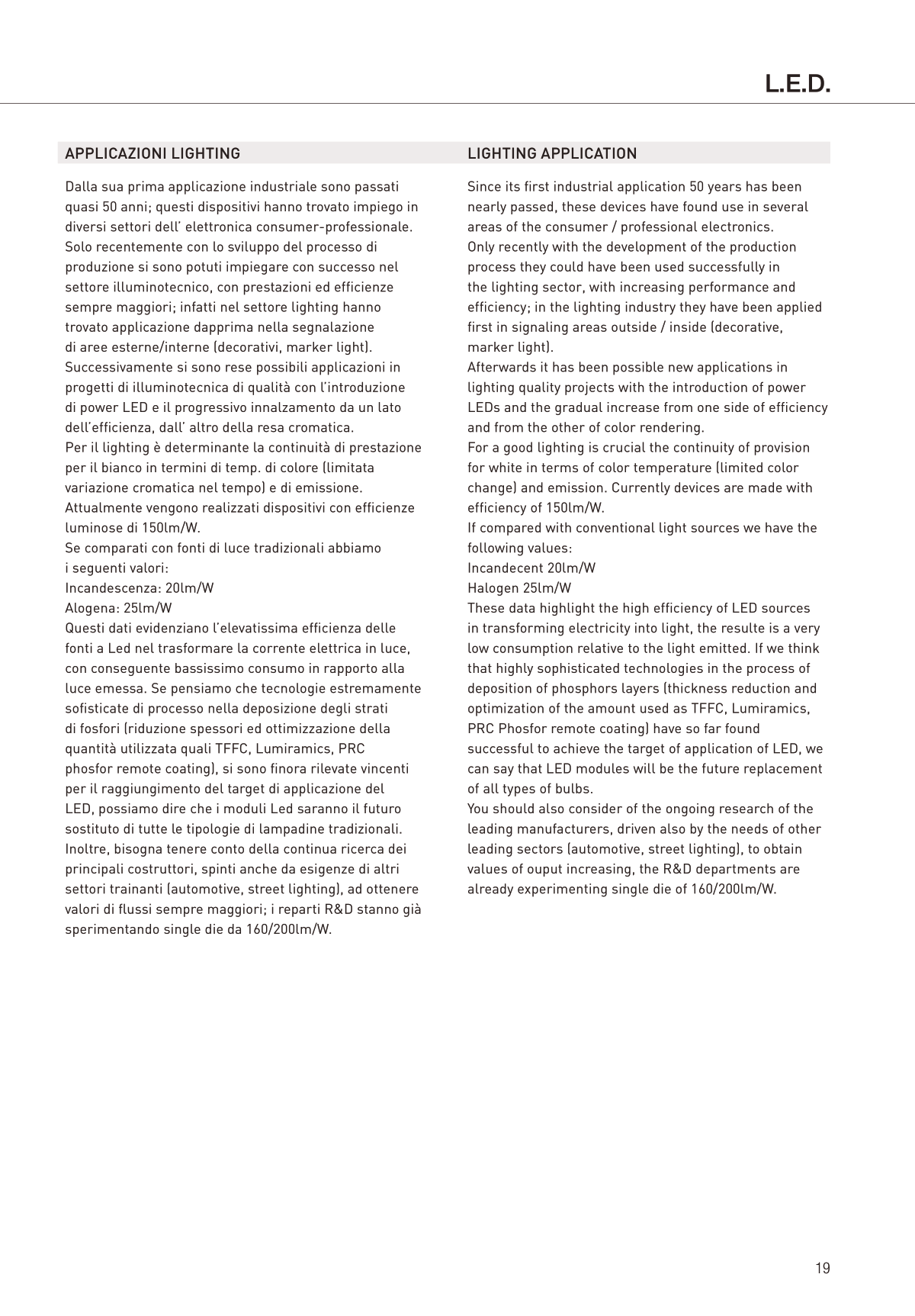APPLICAZIONI LIGHTING
Dalla sua prima applicazione industriale sono passati
quasi 50 anni; questi dispositivi hanno trovato impiego in
diversi settori dell’ elettronica consumer-professionale.
Solo recentemente con lo sviluppo del processo di
produzione si sono potuti impiegare con successo nel
settore illuminotecnico, con prestazioni ed efficienze
sempre maggiori; infatti nel settore lighting hanno
trovato applicazione dapprima nella segnalazione
di aree esterne/interne (decorativi, marker light).
Successivamente si sono rese possibili applicazioni in
progetti di illuminotecnica di qualità con l’introduzione
di power LED e il progressivo innalzamento da un lato
dell’efficienza, dall’ altro della resa cromatica.
Per il lighting è determinante la continuità di prestazione
per il bianco in termini di temp. di colore (limitata
variazione cromatica nel tempo) e di emissione.
Attualmente vengono realizzati dispositivi con efficienze
luminose di 150lm/W.
Se comparati con fonti di luce tradizionali abbiamo
i seguenti valori:
Incandescenza: 20lm/W
Alogena: 25lm/W
Questi dati evidenziano l’elevatissima efficienza delle
fonti a Led nel trasformare la corrente elettrica in luce,
con conseguente bassissimo consumo in rapporto alla
luce emessa. Se pensiamo che tecnologie estremamente
sofisticate di processo nella deposizione degli strati
di fosfori (riduzione spessori ed ottimizzazione della
quantità utilizzata quali TFFC, Lumiramics, PRC
phosfor remote coating), si sono finora rilevate vincenti
per il raggiungimento del target di applicazione del
LED, possiamo dire che i moduli Led saranno il futuro
sostituto di tutte le tipologie di lampadine tradizionali.
Inoltre, bisogna tenere conto della continua ricerca dei
principali costruttori, spinti anche da esigenze di altri
settori trainanti (automotive, street lighting), ad ottenere
valori di flussi sempre maggiori; i reparti R&D stanno già
sperimentando single die da 160/200lm/W.
LIGHTING APPLICATION
Since its first industrial application 50 years has been
nearly passed, these devices have found use in several
areas of the consumer / professional electronics.
Only recently with the development of the production
process they could have been used successfully in
the lighting sector, with increasing performance and
efficiency; in the lighting industry they have been applied
first in signaling areas outside / inside (decorative,
marker light).
Afterwards it has been possible new applications in
lighting quality projects with the introduction of power
LEDs and the gradual increase from one side of efficiency
and from the other of color rendering.
For a good lighting is crucial the continuity of provision
for white in terms of color temperature (limited color
change) and emission. Currently devices are made with
efficiency of 150lm/W.
If compared with conventional light sources we have the
following values:
Incandecent 20lm/W
Halogen 25lm/W
These data highlight the high efficiency of LED sources
in transforming electricity into light, the resulte is a very
low consumption relative to the light emitted. If we think
that highly sophisticated technologies in the process of
deposition of phosphors layers (thickness reduction and
optimization of the amount used as TFFC, Lumiramics,
PRC Phosfor remote coating) have so far found
successful to achieve the target of application of LED, we
can say that LED modules will be the future replacement
of all types of bulbs.
You should also consider of the ongoing research of the
leading manufacturers, driven also by the needs of other
leading sectors (automotive, street lighting), to obtain
values of ouput increasing, the R&D departments are
already experimenting single die of 160/200lm/W.
L.E.D.
19


